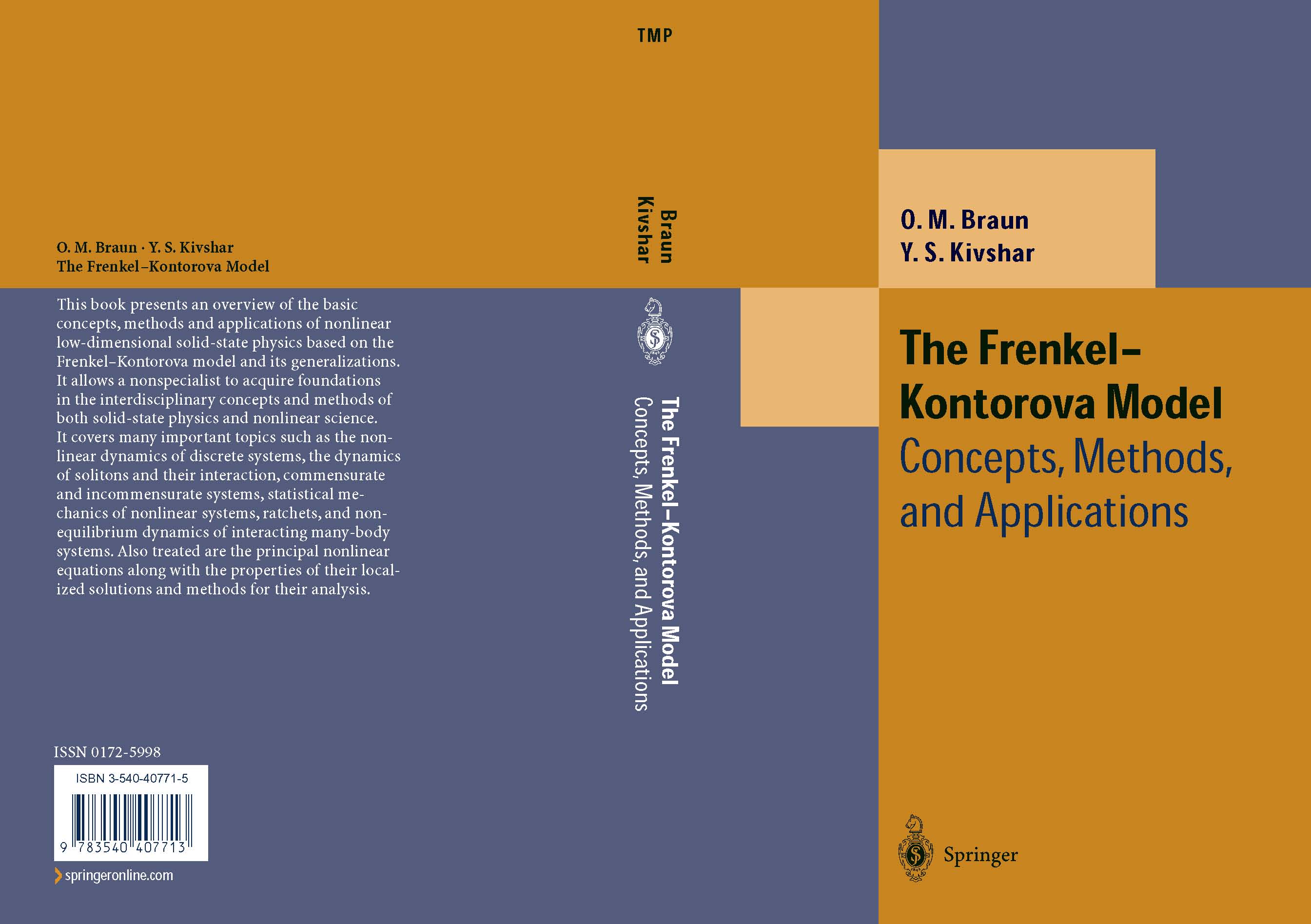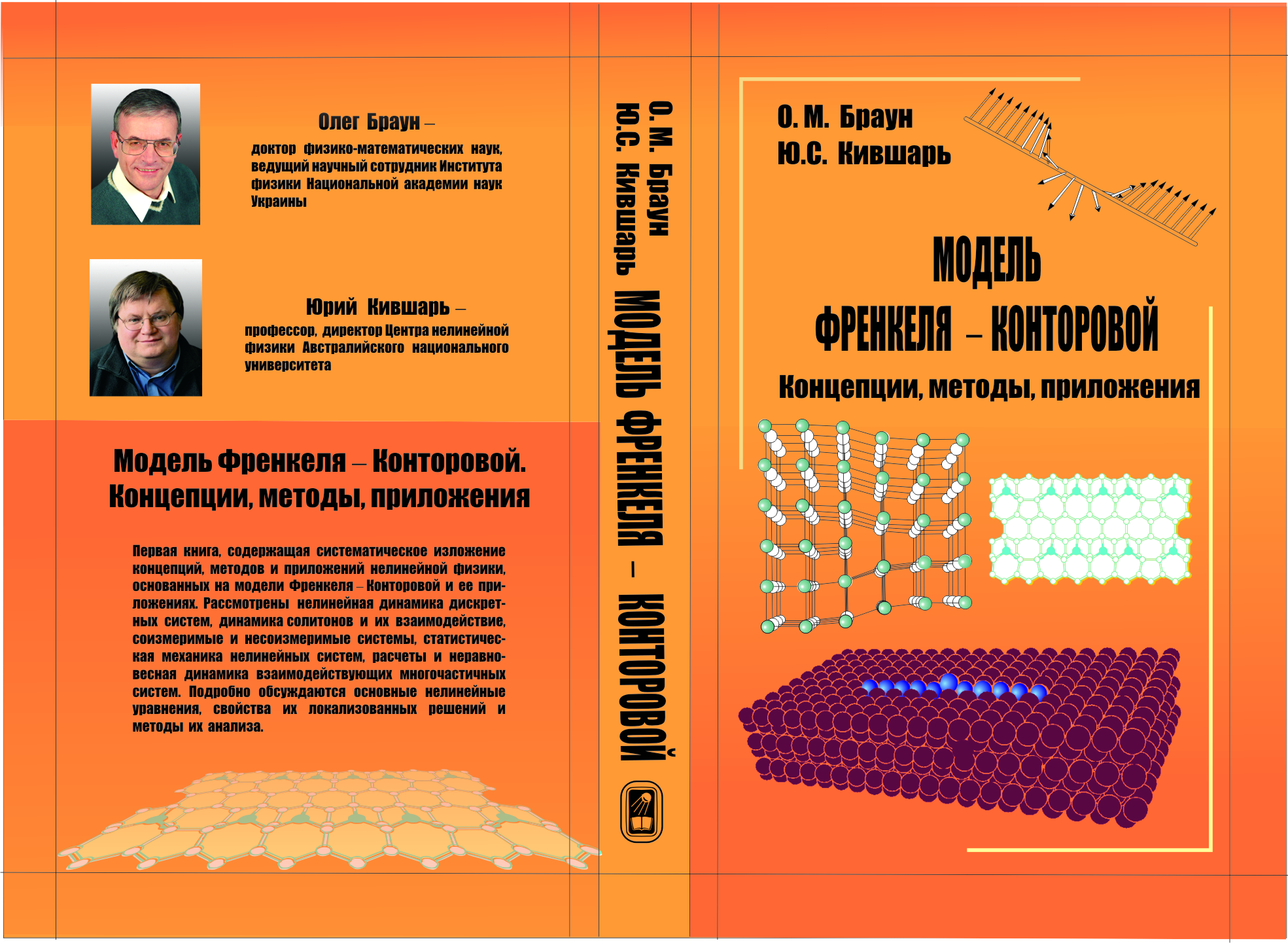Research of Oleg Braun (outline)


My main activity is devoted to condensed matter physics
with applications to surface science and nanotribology.
From a theoretical point of view, most of my work is
connected with nonlinear physics.
Both these areas are described below in more detail. In the research, I widely
use computer simulation. However, I also exactly solved the following problems
of a general interest
proposed and studied the following new models
and obtained the following new results
-
Interaction between adsorbed atoms
-
In a series of papers I studied the interaction
of an adsorbed atom with the substrate,
which properly takes into account the electrostatic
interaction (the "image forces")
and the interaction between adsorbed atoms
both for short and large distances between the atoms.
These results are summarized in the review paper
Usp. Fiz. Nauk 157 (1989) 631 (with V.K. Medvedev)
-
Energy exchange on the surface
-
In another series of papers I investigated
different mechanisms of energy exchange between
an adsorbed atom and the substrate as well as
between different degrees of freedom of the adsorbate.
This topic is connected with vibrational spectroscopy of adsystems.
A theory of stimulated processes was also developed.
The results are summarized in the review paper
Usp. Fiz. Nauk 158 (1989) 421 (with A.I. Volokitin and V.P. Zhdanov)
-
Surface diffusivity and crystal growth
-
A long series of papers is devoted to surface dynamics.
First, a general method of calculation of the diffusion coefficient for any symmetry
of the lattice with a complex elementary cell
in the framework of the lattice-gas (LG) model has been developed.
Then, a new
LG-type model with anisotropic probabilities
of atomic jumps was proposed and solved. This model
predicts a non-uniform diffusion profile observed experimentally.
The diffusion of a single adatom in a two-dimensional
substrate potential as well as the motion of a dimer
and the role of entropy barriers were studied.
The collective diffusion mechanism has been studied
in the framework of the generalized
Frenkel-Kontorova model.
In particular,
dependence of the diffusion coefficient
on the concentration of adatoms was elaborated,
the
reconstructive crystal growth and the
solitonic-exchange diffusion were investigated
with the help of the "zigzag" Frenkel-Kontorova model.
These results are summarized in the survey
Physics Reports 306 (1998) 1
and the
monograph on the FK model (with Yu.S. Kivshar)
- Tribology
-
Finally, my recent activity is devoted to dynamics
of a thin lubricant layer confined between two solid substrates
in a moving contact.
A theory of
melting of a thin confined film has been developed.
The algorithm with a realistic damping coefficient
in Langevin equations has been constructed.
The simulation allowed us to calculate the friction
coefficient for different parameters of the model.
Different regimes were found and investigated,
in particular, the
"perfect-sliding" regime for a solid lubricant.
A minimal velocity for the transition from smooth
sliding to stick-slip in a single frictional contact was determined. The experimentally observed stick-slip motion at low driving velocities
was explained in the framework of the
earthquake-like model.
Self-ordering of the lubricant due to sliding-induced heating which leads to
almost perfect sliding with a very low friction (superlubricity) has been predicted and studied.
Role of the shape of lubricant molecules (either
linear or spherical) was studied.
Recently, a new approach based on the
earthquake-like model with a distribution of static thresholds is developed.
Some of these results are summarized in the survey
Surface Science Reports 60 (2006) 79
(with A.G. Naumovets) (see also a short review in
Russian or
English
"Нанотрибология: механизмы трения на атомном уровне", опубликованном в сборнике
"Актуальные проблемы современного материаловедения" под редакцией И.К. Походни,
том 2, стр. 253-268, Киев, "Академпериодика", 2008, посвященном 90-летию
академика Бориса Евгеньевича Патона, президента Национальной академии наук
Украины, а також наукове
повідомлення на засіданні Президії НАН України 24 жовтня 2012 року
"Сучасні уявлення про механізми тертя"
(& draft))
- Generalized Frenkel-Kontorova model
-
In a series of papers I studied the chain of
anharmonically interacting atoms
subjected to the external periodic potential.
The ground state and its excitations, the Newtonian
and Langevin dynamics of the model were investigated.
The role of
impurities was studied in detail.
Motion of a finite atomic chain
(the "caterpillar" motion) was described.
The scalar two-dimensional Frenkel-Kontorova model
for a system of interacting chains
was proposed and studied (with Yu.S. Kivshar and A.M. Kosivich).
Most of these results have been applied to
problems of surface diffusion
-
Zigzag FK model
-
A new model, called as the "zigzag"
Frenkel-Kontorova model, where the atoms are allowed to move
not only along the chain as in the classical
Frenkel-Kontorova model, but also in the transverse
direction, was proposed (with Yu.S. Kivshar)
and studied in detail.
This model predicts, in particular, new interesting phenomena such as
the
reconstructive crystal growth,
the
solitonic-exchange mechanism of surface diffusion,
the fuse-safety device on an atomic scale, etc.
- Driven systems
-
The nonlinear mobility of a system of interacting atoms
in the external periodic potential
was studied in a series of papers.
Phase diagrams for one- and
two-dimensional systems have been constructed.
The supersonic and multiple kinks were found
and their properties were investigated.
A mechanism of instability of the fast driven kink has been studied in detail.
The multi-step transition from the locked ground state
to the running steady state
was investigated. In particular, the regime of traffic jams
was discovered and explained.
Different scenarios of the locked-to-running
transition were studied in detail
both for one- and two-dimensional variants of the model.
These results are mainly applied to tribological problems
Last updated on September 26, 2008 by Oleg Braun
Translated from LATEX by
HEVEA



